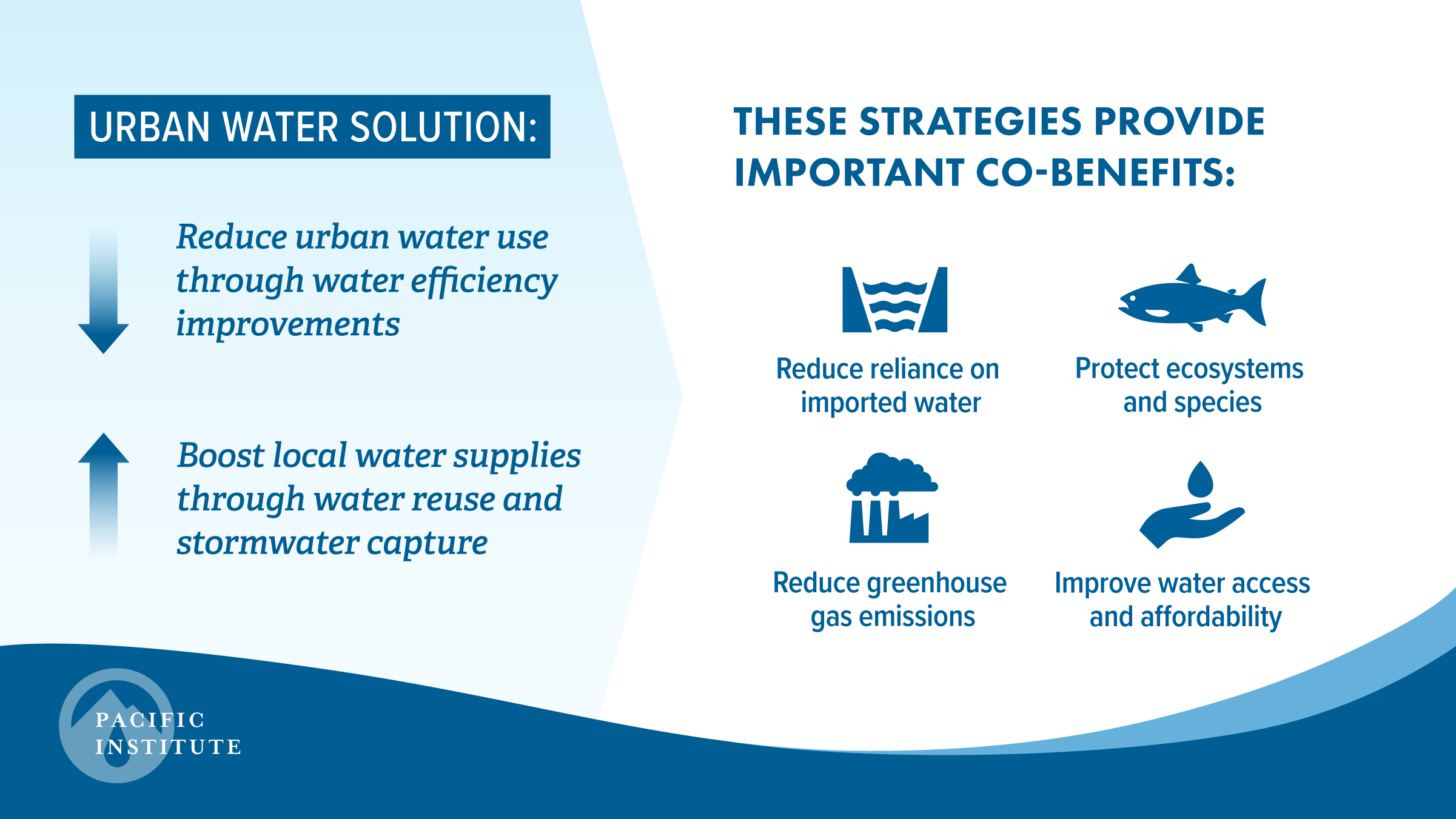Study Reveals California Could Reduce Urban Water Use by More than 30% Through Efficiency Efforts,
More than Triple Water Reuse, Boost Stormwater Capture
April 12, 2022, Oakland, California – Today, as California faces its third year of severe drought, the Pacific Institute released new research quantifying dramatic opportunities for innovative urban water strategies to provide drought relief and longer-term water resilience. “The Untapped Potential of California’s Urban Water Supply: Water Efficiency, Water Reuse, and Stormwater Capture” reveals the state could reduce urban water use by 30%-48% through investments in water efficiency measures. The analysis also highlights the potential to boost local water supplies by more than tripling municipal water reuse and significantly increasing stormwater capture across the state. While the findings are specific to California, they can inform water resilience strategies across the United States and beyond.

Urban water use in California is estimated at 6.6 million acre-feet per year. The report finds these urban water strategies to be technologically feasible and cost effective. It also outlines co-benefits, including decreasing reliance on imported water, protecting threatened ecosystems, and reducing greenhouse gas emissions.
“In the face of severe drought intensifying due to climate change, California and other drought-prone areas must abandon outdated 20th century approaches overly reliant on unsustainable surface water and groundwater withdrawals,” said Heather Cooley, Director of Research at the Pacific Institute. “We must transition to a 21st century model that builds water resilience. The good news is that many communities across California are already successfully implementing these innovative water strategies. This report shows that by rapidly scaling these strategies across the state, millions more Californians could see short-term drought relief and longer-term improvements in their water supply reliability.”
Findings of the analysis include:
- Water efficiency potential: Further implementation of water efficiency measures, including replacing inefficient clothes washers and other appliances with high-efficiency models, replacing lawns with climate-appropriate plants, and reducing losses in water distribution systems, could reduce California’s urban water use by 2.0 million to 3.1 million acre-feet per year, representing a 30% to 48% statewide urban water-use savings.
- Water reuse potential: Municipal water reuse could be more than tripled in California, significantly adding to local water supplies. As estimated 728,000 acre-feet of municipal wastewater is currently reused annually for groundwater recharge, landscape irrigation, and other beneficial use across the state. This new assessment identifies the potential to increase water reuse in California by 1.8 million to 2.1 million acre-feet annually. This would bring total statewide reuse to 2.5 million to 2.8 million acre-feet per year.
- Stormwater capture potential: Urban stormwater capture potential in the state ranges from 580,000 acre-feet in a dry year to 3 million acre-feet in a wet year in urban areas overlying public supply aquifers. There is no statewide estimate of current stormwater capture volume.
The study’s regional findings quantify the potential for these urban water strategies in specific hydrologic regions, with the most significant potential by volume in the South Coast, San Francisco Bay, and Sacramento River hydrologic regions. California’s South Coast hydrologic region, which includes major cities like Los Angeles and San Diego, has the greatest potential for all three strategies. The analysis finds the region could save an additional 1.1 million to 1.7 million acre-feet of water annually through efficiency measures. The region could also boost local water supplies with up to 1.1 million acre-feet of additional reused water and 370,000 acre-feet (dry year) to 1.9 million acre-feet (wet year) using stormwater capture.
The study includes detailed policy and practice recommendations for water utilities and suppliers, as well as local, regional, state, and federal agencies and policymakers. These recommendations include:
- Water efficiency: Increase state and federal funding; expand local water agencies’ customer incentive programs, including through partnerships with energy utilities; increase accessibility of customer programs for low-income and multi-family households; and provide technical support for achieving water efficiency standards under SB 555 and AB 1668/SB 606.
- Water reuse: Increase state and federal funding, including from the bipartisan infrastructure legislation; continue development of regulations supporting potable and onsite water reuse; and re-evaluate water recycling regulatory frameworks to ensure they protect public health and the environment while not imposing unnecessary costs.
- Stormwater Capture: Create a framework to help urban communities identify the optimal mix of centralized and decentralized stormwater capture projects; pursue ordinances and permitting provisions that strongly promote or require the use of low-impact development and stormwater and greywater; and develop state and/or regional funding and coordination policies and programs that facilitate public-private stormwater projects.
Read the full report here.
###
Founded in 1987, the Pacific Institute is a global water think tank that combines science-based thought leadership with active outreach to influence local, national, and international efforts in developing sustainable water policies. Its mission is to create and advance solutions to the world’s most pressing water challenges. From working with Fortune 500 companies to disenfranchised communities, the Pacific Institute leads local, national, and international efforts in developing sustainable water policies and delivering meaningful results.

